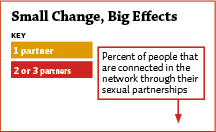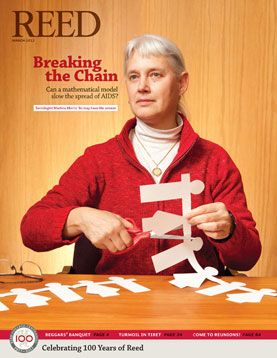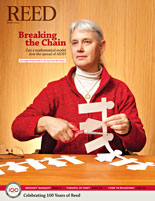
IRIS login | Reed College home Volume 91, No. 1: March 2012
Breaking the Chain
Can a mathematical model slow the spread of AIDS? Sociologist Martina Morris ’80 may have the answer.
By Geoff Koch
The defining moment in Martina Morris’s professional career took place in Uganda in 1993. Fresh out of grad school, she was giving a talk to a small group of African academics and public health workers on her dissertation, which explored how age differences between sexual partners might be related to the spread of the HIV virus.
As she described the mathematical model she used in her research, a man in the audience abruptly stood up.
“Can your model handle people having more than one partner at a time?” he asked.
No, Morris said, it couldn’t. In fact, she added, there was no mathematical model for overlapping partnerships, partly because it was difficult, but mostly because epidemiologists had never considered the issue relevant. Her answer evoked a startling reaction.

Modest variations in the concurrency rate—the proportion of people in overlapping sexual partnerships—can have a dramatic effect on a population’s vulnerability to HIV.
“He got up and walked out of the room,” she says. “This wasn’t a big lecture hall. Everybody saw it. So there was a long silence after he left, and then I just stumbled my way through the rest of my talk.”
Afterwards, the field manager for the project Morris was working on pulled her aside. Many in Uganda were coming to believe that the practice of having concurrent sexual partners might be related to spread of the disease, the manager said.
At first, Morris was skeptical. It was well established that the spread of HIV was related to the number of sexual partners a person had over a given period of time. But who cared, epidemiologically speaking, if those partnerships overlapped? The issue seemed to have more to do with morality than with medicine. As she considered the question more deeply, however, she reached the startling conclusion that the issue of concurrency was fundamentally different from the number of partners—and that it might play a dramatic role in the spread of HIV.
The awkward experience left its mark on Morris, who is now a professor of both sociology and statistics at the University of Washington. Today there is a robust model describing the risks of concurrent sexual partnerships. Morris herself developed it. In a series of papers dating back to the mid-1990s, she has explained the model in great detail, along the way stirring up a surprising controversy.
![]()
Few dispute the basic facts on the ground about HIV in eastern and southern Africa, where more than 22 million people were living with HIV in 2009. Heterosexual sex remains the dominant mode of HIV transmission. The overall prevalence of HIV, though generally stable or falling, remains astonishingly high, at least by American standards: the prevalence in Uganda is estimated at 6.5%, in South Africa at 18%, and in Swaziland more than 25%. And these are figures for the general population. Specific groups, such as urban men aged 15–49, often show much higher prevalence, thousands of times the rate seen in developed nations. This vast difference cannot be explained by what’s generally seen as high-risk behavior: having lots of sexual partners, starting to have sex at an early age, and failing to use condoms. Survey after survey indicates that these behaviors aren’t all that more common in Africa than elsewhere in the world.
The issue is multifaceted for sure. In recent years, much attention has been paid to male circumcision, which does reduce the risk of HIV transmission and is not commonly practiced in Africa. Yet neither is the practice widespread in much of Europe, Asia, or Latin America, where prevalence of HIV is much lower.
So what’s different?
One cultural norm that does seem to vary is the practice of having a small number of overlapping sexual partners. There are many scenarios, but the classic example is the husband who also keeps a mistress, or a “side dish,” as it’s known in Uganda.
Data from a 2011 paper by Morris and colleagues in the journal PLoS ONE drive the point home. Among various groups of men surveyed in Uganda, anywhere from 27 to 32% admit to overlapping partnerships at some point in the last three years, the researchers report. In contrast, concurrency rates among men in the United States typically range from 9 to 23%, depending on race and ethnicity.
That may not sound like a big difference, but Morris’s research suggests that minor variations in sexual concurrence can lead to vast increases in overall transmission of HIV. The reasons are twofold. First, HIV is much more virulent in the early stages of infection, so the chance of transmitting the virus is higher in overlapping partnerships because the interval between sexual contact with different partners is considerably reduced. (No courtship or chocolates to slow things down.)
Second, in an overlapping partnership, you go back to your previous partner, exposing her or him to whatever you picked up in the meantime. Concurrence is not so much a risk to individuals (it has the same effect as multiple partners) as it is to their partners, who are unwittingly exposed to infection without ever engaging in risky behavior.
Take a theoretical group of people where the concurrency rate is 55% (not as unusual as you might like to believe). On any given day, roughly 2% of this group is sexually connected to a larger network, exposing them to infection. Now nudge the concurrency rate up to 63%. Suddenly, the vulnerable population jumps to 41%. Push concurrency to 65%, and the vulnerable population vaults to 64%. Minor changes in concurrency, in other words, have profound implications for the spread of the virus.
In sub-Saharan Africa, Morris believes, the elevated rates of concurrency create what amounts to an HIV superhighway, exposing vast numbers of people to infection.
“In a sense, what you have is a system like the interstate highways in the United States,” says journalist and public health consultant Helen Epstein, who coauthored the 2011 paper with Morris. “Each town isn’t connected to very many other towns, but you can get anywhere across the continent on that system.”
Perhaps the most significant aspect of Morris’s work is its corollary. If concurrency is the key to understanding the spread of HIV, concurrency is also the key to reducing it.
“He got up and walked out of the room,” she says. “This wasn’t a big lecture hall. Everybody saw it. So there was a long silence after he left, and then I just stumbled my way through the rest of my talk.”
![]()



LATEST COMMENTS
steve-jobs-1976 I knew Steve Jobs when he was on the second floor of Quincy. (Fall...
Utnapishtim - 2 weeks ago
Prof. Mason Drukman [political science 1964–70] This is gold, pure gold. God bless, Prof. Drukman.
puredog - 1 month ago
virginia-davis-1965 Such a good friend & compatriot in the day of Satyricon...
czarchasm - 4 months ago
John Peara Baba 1990 John died of a broken heart from losing his mom and then his...
kodachrome - 7 months ago
Carol Sawyer 1962 Who wrote this obit? I'm writing something about Carol Sawyer...
MsLaurie Pepper - 8 months ago
William W. Wissman MAT 1969 ...and THREE sisters. Sabra, the oldest, Mary, the middle, and...
riclf - 10 months ago